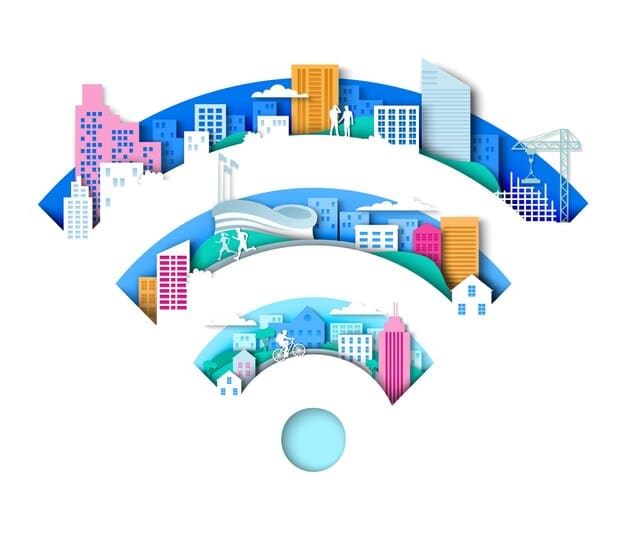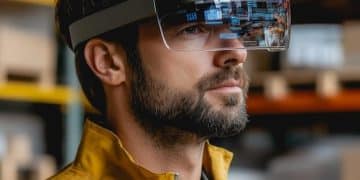US Tech Startups: Leveraging 5G for Product Development

The advent of 5G technology presents an unparalleled opportunity for US tech startups to revolutionize product development by enabling ultra-low latency, massive connectivity, and unprecedented bandwidth, fostering innovation across various sectors.
The landscape of technological innovation is constantly evolving, with new breakthroughs continuously redefining what’s possible. One such transformative force is 5G, the fifth generation of cellular technology. For US tech startups, understanding how can US tech startups leverage 5G for enhanced product development is not just an advantage, but a critical imperative in a competitive global market. This ubiquitous connectivity paradigm can unlock new frontiers, from augmented reality to smart city infrastructure, fundamentally altering the way products are conceived, designed, and delivered.
Understanding 5G: A New Era of Connectivity
The promise of 5G extends far beyond simply faster download speeds. It represents a fundamental shift in networking capabilities, offering three primary characteristics: enhanced mobile broadband (eMBB), ultra-reliable low-latency communications (URLLC), and massive machine-type communications (mMTC). These pillars collectively open up unprecedented possibilities for product innovation and service delivery.
Enhanced mobile broadband provides significantly higher data rates and capacities, making bandwidth-intensive applications commonplace. Consider rich media streaming, high-definition video conferencing, and instantaneous cloud access becoming seamless experiences. For startups building consumer applications, this means delivering richer, more immersive content directly to users without buffering or delay. This can transform entertainment, education, and even social interaction platforms.
Ultra-reliable low-latency communications, perhaps the most revolutionary aspect, slashes the time it takes for data to travel between devices and networks. Latency can drop to as low as one millisecond, a near-instantaneous response time. This is critical for applications demanding real-time control and precision, such as remote surgery, autonomous vehicles, and industrial automation. Startups operating in these fields can design products that respond with an accuracy previously unattainable through wireless means, opening up entirely new markets.
Finally, massive machine-type communications enable a vastly larger number of devices to connect to the network simultaneously. This is the bedrock of the Internet of Things (IoT), where everything from smart home appliances to city-wide sensor networks can communicate efficiently without congesting the network. Startups focused on IoT solutions can scale their deployments significantly, gathering more data and offering more comprehensive environmental or operational insights. This capability supports the development of complex smart ecosystems, integrating diverse sensors and actuators into coherent systems.
Key Pillars of 5G That Drive Innovation
- Ultra-low Latency: Enables real-time control, crucial for autonomous systems and remote operations.
- Massive Bandwidth: Supports high-definition streaming, virtual reality, and cloud-native applications effortlessly.
- High Device Density: Allows billions of IoT devices to connect simultaneously, forming vast sensor networks.
- Network Slicing: Customizable network segments for specific applications, ensuring dedicated performance.
These core capabilities of 5G are not just incremental improvements; they are foundational changes that rewrite the rules of product development. Startups that grasp these nuances will be best positioned to innovate and capture new markets. The integration of 5G requires not just software adaptation but often hardware redesign, providing a ripe area for hardware startups specializing in 5G-ready devices.
The network slicing feature of 5G is particularly compelling for startups. It allows portions of the network to be virtually segmented and optimized for specific use cases, such as a dedicated slice for mission-critical IoT devices in a factory setting or a high-bandwidth slice for a live AR concert. This level of customization ensures that products perform reliably under specific conditions, without competing for resources with other types of traffic, thus guaranteeing service level agreements (SLAs).
By leveraging these distinct features, startups can move beyond conventional product design. They can create products that are not only smarter but also more resilient and adaptable to changing demands. The low latency, for example, allows computationally intensive tasks to be offloaded to edge computing nodes, reducing the need for powerful on-device processors and enabling smaller, lighter form factors. This can lead to breakthroughs in wearable technology and ubiquitous computing.
Augmented and Virtual Reality (AR/VR) as a 5G Catalyst
One of the most immediate and impactful beneficiaries of 5G’s capabilities is the extended reality (XR) space, encompassing augmented reality (AR) and virtual reality (VR). These technologies demand vast amounts of data to be processed and rendered in real-time, often requiring instantaneous feedback to prevent motion sickness and ensure a truly immersive experience. Previous network generations simply couldn’t keep pace with these demands, leading to cumbersome experiences or limited functionality. 5G fundamentally changes this dynamic.
For AR, 5G’s low latency means that digital overlays can be seamlessly integrated into the real world, reacting instantly to user movements and environmental changes. Imagine an architect walking through a proposed building design in real-time, making adjustments that are reflected without any perceptible delay. Or a field technician using AR glasses to receive expert guidance on equipment repair, with digital annotations appearing precisely where needed. Startups developing AR applications for industrial training, remote assistance, or even retail experiences can now deliver highly responsive and engaging solutions.
In VR, the massive bandwidth of 5G enables the streaming of high-fidelity, photorealistic environments directly to VR headsets, potentially eliminating the need for bulky computing devices tethered to the headset. This untethered VR experience is a game-changer for gaming, immersive education, and virtual collaboration. Startups in the entertainment sector can create multiplayer VR experiences that feel truly live, where latency no longer breaks the immersion. Similarly, for educational platforms, virtual field trips to distant locations or historical eras can become a reality, offering rich, interactive learning environments. This pushes the boundaries of what is possible in interactive media and simulations.

Real-World Applications Fueled by 5G for AR/VR Startups
- Remote Collaboration: Teams can virtually assemble in shared digital spaces, making real-time decisions.
- Immersive Training Simulations: High-fidelity training for hazardous jobs without physical risk.
- Interactive Retail Experiences: Customers try on clothes virtually or visualize furniture in their homes.
- Entertainment and Gaming: Untethered VR esports, live concert streaming in virtual venues.
- Healthcare: Remote surgical training, visualization of medical data in 3D.
The ability to offload heavy rendering and processing to edge servers via 5G also means that AR/VR devices can become lighter, more comfortable, and less expensive, further accelerating adoption. This reduction in device complexity can lower the barrier to entry for consumers and businesses alike, expanding the market for innovative AR/VR products. Startups focused on developing novel interfaces or interaction methods within these untethered environments will find a fertile ground for growth.
Moreover, 5G allows for context-aware AR applications that can process data from multiple sensors (e.g., cameras, lidar) and provide real-time environmental understanding. For example, a startup could develop an AR app that helps tourists navigate a new city, providing dynamic information about landmarks, restaurants, and historical facts overlaid onto their view of the streets. The low latency ensures this information updates instantly as they move, creating a truly helpful and intuitive experience.
Enabling the Autonomous Revolution: Vehicles and Robotics
The dream of fully autonomous systems—from self-driving cars to intelligent factory robots—hinges critically on reliable, ultra-low latency communication. 5G provides the foundational network infrastructure that can make this revolution a reality. For US tech startups in the autonomous space, this means overcoming critical limitations that plagued previous generations of connectivity.
Autonomous vehicles, whether cars, drones, or delivery robots, require instantaneous communication for safety and efficiency. They need to communicate with other vehicles (V2V), infrastructure (V2I), pedestrians (V2P), and the broader network (V2N) to gather real-time data about traffic conditions, hazards, and navigation. A delay of even a few milliseconds can be the difference between a safe maneuver and an accident. 5G’s URLLC ensures that these data exchanges happen virtually instantaneously, allowing vehicles to make split-second decisions based on up-to-the-moment information.
Think about platooning, where multiple autonomous trucks drive closely together to reduce drag and fuel consumption. This requires precise, synchronized braking and acceleration across all vehicles, something only achievable with ultra-low latency communication. Startups developing these next-generation logistics solutions can now build robust systems that were previously too risky or inefficient. Similarly, for urban drone delivery services, 5G offers the reliability and coverage needed to manage a fleet of drones, ensuring they can avoid obstacles and deliver packages safely within congested airspaces.
In manufacturing and logistics, 5G is poised to transform factory floors into smart, interconnected environments. Autonomous mobile robots (AMRs) can navigate complex factory layouts, collaborating with human workers and other machines without physical tethers. Low latency enables precise control of robotic arms and machinery, allowing for flexible production lines and remote operation of heavy equipment. Startups creating robotic solutions for specific industrial challenges—from precision assembly to automated warehousing—can now design systems that are more dynamic, responsive, and scalable, reducing operational costs and increasing efficiency for their clients.
Impact Areas for Startups in Autonomous Systems with 5G
- Intelligent Edge Processing: Offloading computation from vehicles to edge nodes for faster decision-making.
- Sensor Fusion Networks: Combining data from real-time vehicle sensors across a wider network for improved perception.
- Remote Control and Teleoperation: Enabling human operators to control autonomous systems from a distance with minimal lag.
- Predictive Maintenance for Autonomous Fleets: Real-time data from autonomous vehicles to predict and prevent failures.
The ability of 5G to support massive device density is also crucial for autonomous environments. A smart factory might have thousands of sensors, robots, and machines all communicating simultaneously. 5G ensures that this dense network operates smoothly, without congestion or interference, providing a stable backbone for advanced automation. This allows startups to develop comprehensive solutions that integrate various smart components into a cohesive, intelligent system, leading to fully automated processes that require minimal human intervention.
Furthermore, the network slicing capability of 5G can provide dedicated, highly secure, and ultra-reliable slices for mission-critical autonomous functions. This level of guaranteed performance is essential for applications where safety and operational continuity are paramount. Startups can offer bespoke 5G-enabled solutions that meet stringent industry standards, opening doors to highly regulated markets like defense and healthcare logistics.
Revolutionizing IoT and Smart Cities with 5G
The potential of the Internet of Things (IoT) has long been discussed, but its full realization has often been hindered by connectivity limitations—specifically, the challenge of connecting billions of devices reliably and efficiently. 5G provides the crucial infrastructure to unleash the full power of IoT, leading to the creation of truly smart cities and hyper-connected industries. For US tech startups, this represents an enormous opportunity to build the backbone and applications for the next generation of connected living.
5G’s massive machine-type communications (mMTC) capability allows an unprecedented number of devices to connect to a single network with low power consumption and extended battery life. This is ideal for widespread sensor deployments in smart cities. Imagine a city where every streetlight, waste bin, parking spot, and traffic light is connected, collecting and transmitting data in real time. Startups can develop platforms that aggregate this data to optimize urban services, from intelligent traffic management systems that reduce congestion to smart waste management solutions that optimize collection routes.
Beyond urban infrastructure, 5G-enabled IoT can transform critical sectors like agriculture. Precision agriculture, for instance, can leverage 5G to connect thousands of sensors across vast farmlands, monitoring soil moisture, nutrient levels, and crop health in real time. Drones equipped with 5G can perform automated surveillance and deliver targeted treatments, leading to increased yields and reduced resource consumption. Startups in AgriTech can develop these intricate sensor networks and AI-powered analytics platforms that provide actionable insights to farmers.
In healthcare, 5G can facilitate the widespread adoption of remote patient monitoring devices, smart hospitals, and telemedicine. Wearable sensors powered by 5G can transmit continuous health data to medical professionals, enabling proactive care and early detection of issues. For startups creating medical devices or health management platforms, 5G ensures the secure and reliable transmission of sensitive patient data, enabling more efficient and personalized healthcare delivery outside traditional clinical settings.

5G-Enabled IoT Startup Opportunities
- Smart Infrastructure Management: Optimizing utilities, public safety, and transportation in urban areas.
- Environmental Monitoring: Real-time tracking of air quality, water levels, and climate data.
- Smart Manufacturing & Industry 4.0: Connecting factory sensors, machinery, and supply chains for predictive maintenance and optimized production.
- Personalized Healthcare IoT: Devices for remote monitoring, assisted living, and virtual clinics.
- Connected Logistics and Supply Chains: Tracking goods in transit, optimizing delivery routes, and managing inventory.
The robustness and security features of 5G also make it suitable for critical infrastructure IoT, such as smart grids and industrial control systems. Startups focusing on cybersecurity solutions for 5G-enabled IoT devices will also find a significant market opportunity, as the increased connectivity necessitates enhanced protection against cyber threats. The ability to deploy private 5G networks further enhances security and control for enterprises, creating a niche for startups offering tailored private network solutions.
Ultimately, 5G allows IoT deployments to move from isolated, fragmented systems to interconnected, intelligent ecosystems. This holistic approach can unlock new synergies between devices and data, leading to innovative cross-sector solutions that address complex challenges, from climate change to resource management. Startups that can integrate various data streams and apply advanced analytics will be at the forefront of this transformation, building next-generation products that offer unprecedented value.
Edge Computing Synergy: Unleashing 5G’s Full Potential
While 5G provides the robust network capabilities, its true transformative power is realized when combined with edge computing. Edge computing involves processing data closer to its source, rather than sending it all the way to a centralized cloud. This synergistic relationship is critical for US tech startups looking to develop low-latency, highly efficient, and data-intensive products, particularly in areas like AI, autonomous systems, and real-time analytics.
The ultra-low latency of 5G is significantly enhanced by edge computing. If data from a sensor or autonomous vehicle has to travel hundreds or thousands of miles to a distant cloud server for processing before a response is sent back, the inherent latency of that round trip defeats some of 5G’s benefits. By placing computational power at the network edge—closer to the devices and users—data can be processed locally and immediately. This drastically reduces the response time, making real-time applications truly viable. Startups working on mission-critical applications where every millisecond counts, such as augmented reality for surgical assistance or real-time robotics control in manufacturing plants, can leverage this combination to deliver unparalleled performance.
Moreover, edge computing addresses bandwidth constraints and privacy concerns. While 5G offers massive bandwidth, transmitting all raw data from billions of IoT devices to the cloud can still be overwhelming and costly. Edge computing allows for preliminary data processing, filtering, and aggregation at the source. Only essential or processed data needs to be sent to the central cloud, reducing network traffic and optimizing storage. For startups dealing with large volumes of sensor data, this can lead to significant cost savings and more efficient data management. Privacy-sensitive data can also be processed and anonymized at the edge, reducing the risk of exposure during transmission to the cloud.
Benefits of Combining 5G with Edge Computing for Product Development
- Reduced Latency: Enables near real-time decision-making for critical applications.
- Enhanced Security: Local processing of sensitive data minimizes exposure.
- Optimized Bandwidth Use: Filters and aggregates data at the edge, reducing backhaul traffic.
- Improved Reliability: Less reliance on persistent cloud connectivity for critical functions.
- New Business Models: Opportunities for startups offering edge-as-a-service or custom edge solutions.
For AI and machine learning startups, edge computing becomes particularly powerful. Training large AI models still typically happens in the cloud, but inference (applying the trained model to new data) can occur at the edge. This means AI-powered applications can deliver intelligent responses instantly, without relying on constant cloud connectivity. Think of a smart camera using AI to detect anomalies on a factory floor: processing happens at the edge, and only alerts are sent to the cloud, allowing for immediate action. Startups specializing in AI-driven analytics, predictive maintenance, or computer vision can develop robust, localized solutions for various industries.
The combination of 5G and edge computing also facilitates the development of “digital twins” – virtual replicas of physical assets, processes, or systems. By collecting data from physical assets in real-time via 5G and processing it at the edge, startups can create highly accurate and up-to-date digital twins. These twins can then be used for simulations, predictive modeling, and optimization, allowing businesses to test scenarios and make informed decisions without disrupting physical operations. This opens up new product lines for industrial automation, smart infrastructure, and even personalized medicine, where individual physiologies could have digital twins for tailored treatments.
Overcoming Challenges and Strategic Considerations
While the opportunities presented by 5G are immense, US tech startups must also navigate several challenges to successfully leverage this technology for enhanced product development. These include the significant investment required, the evolving regulatory landscape, and the need for specialized talent. Strategic planning and a clear understanding of these hurdles are essential for success.
One major consideration is the sheer cost of developing 5G-enabled products and services. Accessing and leveraging 5G infrastructure, along with the specialized hardware and software components, can be a substantial financial undertaking for early-stage companies. Startups will need to secure adequate funding, whether through venture capital, strategic partnerships, or government grants, to cover these development costs. Furthermore, the interoperability of devices and networks remains a complex issue, requiring careful adherence to standards and potentially customized integration efforts.
The regulatory environment for 5G and associated technologies like autonomous vehicles and drone operations is still maturing. Startups must stay abreast of evolving regulations concerning spectrum allocation, data privacy, safety standards, and cross-border data flow. Compliance is not just a legal necessity but also a critical factor in building trust with users and partners. Early engagement with regulatory bodies and industry consortia can help shape these policies favorably and ensure long-term viability for new products.
Key Challenges and Strategic Responses for 5G Startups
- High Development Costs: Seek strategic investors, grants, and explore joint ventures.
- Talent Gap: Invest in upskilling current teams and recruit experts in 5G, edge computing, and AI.
- Regulatory Complexity: Engage with policymakers, ensure product compliance, and proactively address privacy concerns.
- Security Vulnerabilities: Implement end-to-end security measures from design to deployment.
- Evolving Infrastructure: Design flexible solutions adaptable to varying 5G deployment stages (e.g., standalone vs. non-standalone).
Building a team with expertise in 5G architecture, network slicing, edge computing, and specific vertical applications (e.g., AR/VR development, robotics engineering) is another critical challenge. The demand for such specialized talent often outstrips supply, leading to intense competition for skilled professionals. Startups should consider investing in training programs, fostering academic partnerships, and exploring remote or global talent pools to assemble the right team capable of innovating with 5G.
Security is paramount in a hyper-connected 5G world. As more devices and critical systems come online, the attack surface expands exponentially. Startups developing 5G-enabled products must integrate robust cybersecurity measures from the design phase onwards, addressing potential vulnerabilities at every layer—from the device hardware to the network and cloud components. Proactive threat intelligence and rapid incident response capabilities will be crucial to maintaining product integrity and user trust.
Finally, startups need to consider the phased rollout of 5G infrastructure. Not all areas of the US will have the same level of 5G coverage or advanced features (like standalone 5G and edge computing availability) at the same time. Product strategies should account for this variability, perhaps starting with solutions that can adapt to different levels of 5G maturity or targeting specific geographies where advanced 5G is already robust. Building agile solutions that can perform optimally even with less advanced 5G (eMBB) while being ready to exploit URLLC and mMTC as they become more widespread will provide a competitive edge.
Future Outlook for 5G and Startup Innovation
The journey with 5G is still in its early phases, with significant evolution anticipated in the coming years. For US tech startups, staying ahead of these advancements and anticipating future trends will be key to long-term success and continued product innovation. The trajectory of 5G points towards increasingly pervasive and intelligent networks, opening up even more sophisticated possibilities.
One major area of future development is the convergence of 5G with artificial intelligence and machine learning at the network level. AI-powered networks will be able to dynamically optimize resources, predict traffic patterns, and even self-heal, leading to unprecedented levels of efficiency and reliability. Startups that can build AI-native applications that seamlessly integrate with these intelligent networks will find themselves at a distinct advantage, developing products that are not just powered by 5G, but truly enhanced by an intelligent network fabric.
The concept of “network-as-a-service” will also become more prevalent, where developers can programmatically access and control network capabilities like latency, bandwidth, and security profiles through APIs. This will democratize access to advanced 5G features, allowing a broader range of startups to innovate without needing deep telecommunications expertise. Companies providing platforms or tools that abstract away this complexity will empower countless new product developments, fostering a vibrant ecosystem of 5G-enabled services and applications.
Furthermore, the evolution towards 6G, though still distant, will build upon 5G’s foundation, introducing concepts like integrated sensing and communication, ubiquitous AI, and holographic communication. While these are long-term horizons, startups should consider them as potential future directions, ensuring their current product architectures are flexible and scalable enough to adapt to upcoming generational leaps in connectivity. Early research and development into these nascent areas could position a startup as a leader in future markets.
Emerging Trends That Will Shape 5G Startup Opportunities
- Pervasive AI in Networks: Enabling self-optimizing and predictive network operations.
- Network-as-a-Service (NaaS): Programmable network features for developers.
- Integration with Satellite & Non-Terrestrial Networks: Extending 5G coverage globally.
- Advanced XR Experiences: Higher fidelity and more interactive AR/VR/MR environments.
- Digital Twins and Metaverse Applications: Creating hyper-realistic virtual replicas and interconnected virtual worlds.
The role of private 5G networks will continue to expand, moving beyond industrial settings to encompass campuses, smart buildings, and even residential communities. Startups specializing in deploying, managing, and securing these private networks, or developing applications tailored for them, will find a growing market. This localized, high-performance connectivity offers unparalleled control and security, making it ideal for specific enterprise needs where public network reliability or security might be a concern.
Ultimately, the future of 5G, and the startups leveraging it, lies in solving complex real-world problems. From improving healthcare outcomes through remote monitoring to optimizing energy consumption in smart cities, 5G provides the foundational technology. Startups that identify pressing societal or business challenges and creatively apply 5G-enhanced solutions, moving beyond mere technological demonstrations to deliver tangible value, will be the ones that truly thrive and leave a lasting impact. Embracing cross-industry collaboration and open innovation will also be crucial for accelerating discoveries and bringing transformative products to market.
| Key Point | Brief Description |
|---|---|
| 🚀 AR/VR Acceleration | 5G’s low latency and high bandwidth enable truly immersive and untethered AR/VR experiences. |
| 🚗 Autonomous Systems | Ultra-reliable, low-latency 5G communications are critical for real-time decision-making in vehicles and robotics. |
| 💡 IoT & Smart Cities | Massive device density and efficient connectivity drive comprehensive IoT deployments for urban and industrial innovation. |
| ⚡ Edge Computing Synergy | Processing data closer to the source with 5G dramatically reduces latency and optimizes network efficiency. |
Frequently Asked Questions about 5G and Startups
The primary benefit of 5G for tech startups is its ability to enable applications that require extremely low latency, massive device connectivity, and high bandwidth. This supports innovations in areas like real-time AR/VR, autonomous systems, and widespread IoT, which were limited by previous network generations. It allows for the development of entirely new product categories and service models.
5G significantly enhances AR/VR by enabling ultra-low latency and high bandwidth streaming, which reduces motion sickness and allows for untethered, high-fidelity experiences. This means complex rendering can be offloaded to edge servers, making devices lighter and more comfortable while still delivering seamless, immersive digital interactions in real-time. This opens up new possibilities for entertainment, training, and remote collaboration.
Yes, 5G is a critical enabler for fully autonomous vehicles and robotics due to its ultra-reliable low-latency communications (URLLC). Instantaneous data exchange between vehicles, infrastructure, and the network is vital for safety and real-time decision-making. This capability supports precise control, synchronized movements (like platooning), and efficient fleet management in complex environments, making autonomous operations safer and more reliable.
Edge computing complements 5G by processing data closer to its source, minimizing the round-trip time to centralized cloud servers. This synergy drastically reduces latency, enhances security by localized processing, and optimizes bandwidth usage by sending only essential data to the cloud. For startups, this enables ultra-responsive AI applications, real-time analytics, and more robust decentralized systems.
Key challenges for US tech startups include the high cost of 5G-enabled development, the competitive talent landscape for specialized skills, and navigating evolving regulatory frameworks for new technologies. Additionally, ensuring robust cybersecurity for widespread connected devices and adapting products to the phased rollout of 5G infrastructure across different regions are significant hurdles that require strategic planning.
Conclusion
The convergence of 5G with burgeoning technologies like AI, AR/VR, IoT, and edge computing represents a pivotal moment for US tech startups. Far from being a mere speed upgrade, 5G provides a foundational network capability that enables entirely new paradigms of product development, from deeply immersive digital experiences to truly autonomous systems. While challenges remain in terms of investment, talent, and regulation, the strategic embrace of 5G’s unique characteristics—ultra-low latency, massive connectivity, and unprecedented bandwidth—offers a clear pathway to unlocking innovative solutions and securing a competitive edge in the rapidly evolving global technology landscape. Startups that proactively integrate 5G into their core strategies are not just building for today; they are shaping the digitally connected future.





